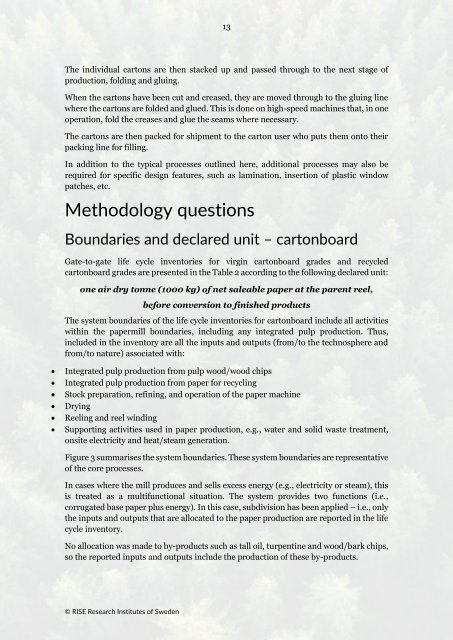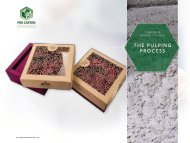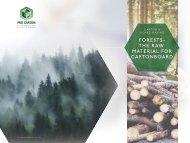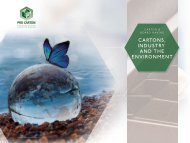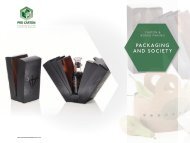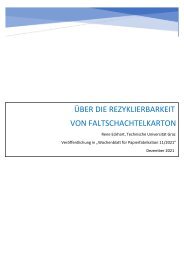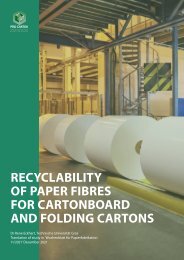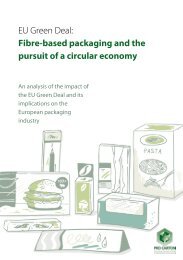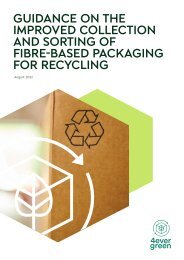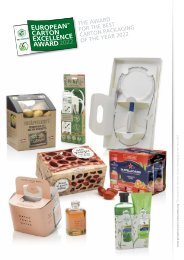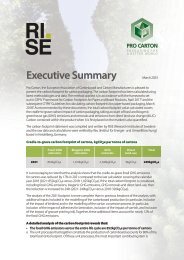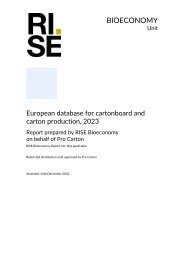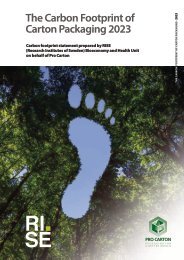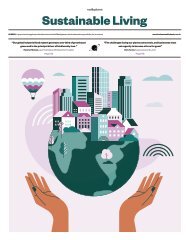European Database for Cartonboard and Carton Production 2023
Create successful ePaper yourself
Turn your PDF publications into a flip-book with our unique Google optimized e-Paper software.
13<br />
The individual cartons are then stacked up <strong>and</strong> passed through to the next stage of<br />
production, folding <strong>and</strong> gluing.<br />
When the cartons have been cut <strong>and</strong> creased, they are moved through to the gluing line<br />
where the cartons are folded <strong>and</strong> glued. This is done on high-speed machines that, in one<br />
operation, fold the creases <strong>and</strong> glue the seams where necessary.<br />
The cartons are then packed <strong>for</strong> shipment to the carton user who puts them onto their<br />
packing line <strong>for</strong> filling.<br />
In addition to the typical processes outlined here, additional processes may also be<br />
required <strong>for</strong> specific design features, such as lamination, insertion of plastic window<br />
patches, etc.<br />
Methodology questions<br />
Boundaries <strong>and</strong> declared unit – cartonboard<br />
Gate-to-gate life cycle inventories <strong>for</strong> virgin cartonboard grades <strong>and</strong> recycled<br />
cartonboard grades are presented in the Table 2 according to the following declared unit:<br />
one air dry tonne (1000 kg) of net saleable paper at the parent reel,<br />
be<strong>for</strong>e conversion to finished products<br />
The system boundaries of the life cycle inventories <strong>for</strong> cartonboard include all activities<br />
within the papermill boundaries, including any integrated pulp production. Thus,<br />
included in the inventory are all the inputs <strong>and</strong> outputs (from/to the technosphere <strong>and</strong><br />
from/to nature) associated with:<br />
• Integrated pulp production from pulp wood/wood chips<br />
• Integrated pulp production from paper <strong>for</strong> recycling<br />
• Stock preparation, refining, <strong>and</strong> operation of the paper machine<br />
• Drying<br />
• Reeling <strong>and</strong> reel winding<br />
• Supporting activities used in paper production, e.g., water <strong>and</strong> solid waste treatment,<br />
onsite electricity <strong>and</strong> heat/steam generation.<br />
Figure 3 summarises the system boundaries. These system boundaries are representative<br />
of the core processes.<br />
In cases where the mill produces <strong>and</strong> sells excess energy (e.g., electricity or steam), this<br />
is treated as a multifunctional situation. The system provides two functions (i.e.,<br />
corrugated base paper plus energy). In this case, subdivision has been applied – i.e., only<br />
the inputs <strong>and</strong> outputs that are allocated to the paper production are reported in the life<br />
cycle inventory.<br />
No allocation was made to by-products such as tall oil, turpentine <strong>and</strong> wood/bark chips,<br />
so the reported inputs <strong>and</strong> outputs include the production of these by-products.<br />
© RISE Research Institutes of Sweden


